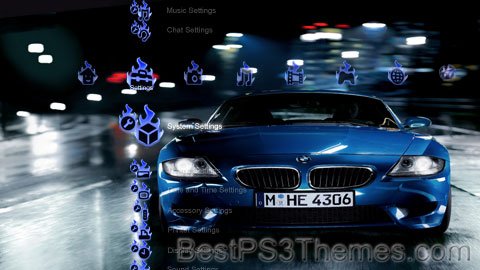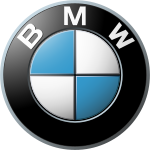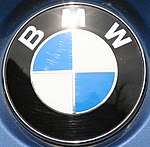BMW theme by Ianes93
Download: BMW.p3t

(7 backgrounds)
 | |
 BMW Headquarters in Munich, Germany | |
| Formerly | Rapp Moterenwerke AG |
|---|---|
| Company type | Public (Aktiengesellschaft) |
| FWB: BMW DAX component | |
| Industry | Automotive |
| Predecessors | |
| Founded | 27 October 1913 (as Rapp Motorenwerke) |
| Founder | Karl Rapp |
| Headquarters | , Germany |
Area served | Worldwide |
Key people |
|
| Products | |
Production output |
|
| Brands |
|
| Services | Car-sharing services, financing, leasing, insurance and other financial services |
| Revenue | |
| Total assets | |
| Total equity | |
| Owners |
|
Number of employees | 149,475 (2022)[1] |
| Website |
|
Bayerische Motoren Werke AG, commonly abbreviated to BMW (German pronunciation: [ˌbeːʔɛmˈveː] ), is a German multinational manufacturer of luxury vehicles and motorcycles headquartered in Munich, Bavaria, Germany. The company was founded in 1916 as a manufacturer of aircraft engines, which it produced from 1917 to 1918 and again from 1933 to 1945 creating engines for aircraft that were used in the Second World War.
Automobiles are marketed under the brands BMW, Mini and Rolls-Royce, and motorcycles are marketed under the brand BMW Motorrad. In 2017, BMW was the world's fourteenth-largest producer of motor vehicles, with 2,279,503 vehicles produced[3] and in 2022 the 7th largest by revenue.[4] In 2023, the company was ranked 46th in the Forbes Global 2000.[5] The company has significant motor-sport history, especially in touring cars, sports cars, and the Isle of Man TT.
BMW is headquartered in Munich and produces motor vehicles in Germany, Brazil, China, India, Mexico, the Netherlands, South Africa, the United Kingdom, and the United States. The Quandt family is a long-term shareholder of the company, following investments by the brothers Herbert and Harald Quandt in 1959 that saved BMW from bankruptcy, with the remaining shares owned by the public.
History[edit]
The Otto Flugmaschinenfabrik was founded in 1910 by Gustav Otto in the Kingdom of Bavaria, which was a state of the German Empire. The firm was reorganized on 7 March 1916 into Bayerische Flugzeugwerke AG. This company was then renamed to Bayerische Motoren Werke (BMW) in 1922. However, the name BMW dates back to 1913, when a company to use the name was founded by Karl Rapp initially as Rapp Motorenwerke. The name and Rapp Motorenwerke's engine-production assets were transferred to Bayerische Flugzeugwerke in 1922, who adopted the name the same year.[6] BMW's first product was produced for fighter aircraft of the Luftstreitkräfte. It was a straight-six aircraft engine called the BMW IIIa, designed in the spring of 1917 by engineer Max Friz. Following the end of World War I, BMW remained in business by producing motorcycle engines, agricultural equipment, household items, and railway brakes. The company produced its first motorcycle, the BMW R 32, in 1923.
BMW became an automobile manufacturer in 1928 when it purchased Fahrzeugfabrik Eisenach, which, at the time, built the Austin 7 under licence from Dixi.[7] The first car sold as a BMW was a rebadged BMW Dixi called the BMW 3/15, following BMW's acquisition of the car manufacturer Automobilwerk Eisenach. Throughout the 1930s, BMW expanded its range into sports cars and larger luxury cars.
Aircraft engines, motorcycles, and automobiles would be BMW's main products until World War II. During the war, BMW concentrated on the BMW 801 aircraft engine using as many as 40,000 slave laborers.[8] These consisted primarily of prisoners from Nazi concentration camps, most prominently Dachau. Motorcycles remained as a side-line and automobile manufacture ceased altogether.
BMW's factories were heavily bombed during the war and its remaining West German facilities were banned from producing motor vehicles or aircraft after the war. Again, the company survived by making pots, pans, and bicycles. In 1948, BMW restarted motorcycle production. BMW resumed car production in Bavaria in 1952 with the BMW 501 luxury saloon. The range of cars was expanded in 1955, through the production of the cheaper Isetta microcar under licence. Slow sales of luxury cars and small profit margins from microcars meant BMW was in serious financial trouble and in 1959 the company was nearly taken over by rival Daimler-Benz.[citation needed]
A large investment in BMW by Herbert Quandt and Harald Quandt resulted in the company surviving as a separate entity. Günther Quandt, was a well-known German industrialist, joined the Nazi party in 1933 and made a fortune arming the German Wehrmacht, manufacturing weapons and batteries.[9] Many of his enterprises were appropriated from Jewish owners under duress with minimal compensation. At least three of his enterprises made extensive use of slave laborers, as many as 50,000 in all.[10] One of his battery factories had its own on-site concentration camp, complete with gallows. Life expectancy for laborers was six months.[10][11] While Quandt and BMW were not directly connected during the war, funds amassed in the Nazi era by his father allowed Herbert Quandt to buy BMW.[8]
The relative success of the small BMW 700 assisted in the company's recovery, allowing them to develop the New Class sedans.

The 1962 introduction of the BMW New Class compact sedans was the beginning of BMW's reputation as a leading manufacturer of sport-oriented cars. Throughout the 1960s, BMW expanded its range by adding coupé and luxury sedan models. The BMW 5 Series mid-size sedan range was introduced in 1972, followed by the BMW 3 Series compact sedans in 1975, the BMW 6 Series luxury coupés in 1976 and the BMW 7 Series large luxury sedans in 1978.
The BMW M division released its first road car, a mid-engine supercar, in 1978. This was followed by the BMW M5 in 1984 and the BMW M3 in 1986. Also in 1986, BMW introduced its first V12 engine in the 750i luxury sedan. The 1989 BMW Z1 marked BMW's return to making a two-seat roadster, the 1995 BMW Z3 was their first mass-production two-seat roadster, and the 1999 BMW X5 was the company's first entry into the SUV market.
The company purchased the Rover Group in 1994, but the takeover was not successful and caused BMW large financial losses. In 2000, BMW sold off most of the Rover brands, retaining only the Mini brand. In 1998, BMW also acquired the rights to the Rolls-Royce brand from Vickers.
The first modern mass-produced turbocharged petrol engine was introduced in 2006 (from 1973 to 1975, BMW built 1,672 units of a turbocharged BMW M10 engine for the BMW 02 Series),[12] with most engines switching over to turbocharging over the 2010s. The first hybrid BMW was the 2010 BMW ActiveHybrid 7, and BMW's first mass-production electric car was the BMW i3 city car, which was released in 2013, (from 1968 to 1972, BMW built two battery-electric BMW 1602 Elektro saloons for the 1972 Olympic Games).[13] After many years of establishing a reputation for sporting rear-wheel drive cars, BMW's first front-wheel drive car was the 2014 BMW 2 Series Active Tourer multi-purpose vehicle (MPV).
21st century[edit]
In January 2021, BMW announced that its sales in 2020 fell by 8.4 percent due to the impact of COVID-19 pandemic restrictions. However, in the fourth quarter of 2020, BMW witnessed a rise of 3.2% in its customers' demands.[14]
On 18 January 2022 BMW announced a BMW 7 Series (G11) special edition simply called "The Final V12",[15] the last BMW series production vehicle to be fitted with a V-12 engine.[15]
On 5 October 2023 it was announced that BMW UK CEO Chris Brownridge would succeed Torsten Müller-Ötvös as the CEO of Rolls-Royce starting 1 December 2023, as a result of Müller-Ötvös retiring.[16]
Branding[edit]
Company name[edit]
BMW is an abbreviation for Bayerische Motoren Werke (German pronunciation: [ˈbaɪ̯ʁɪʃə mɔˈtʰɔʁn̩ ˈvɛɐ̯kə]). This name is grammatically incorrect (in German, compound words must not contain spaces), which is why the grammatically correct form of the name, Bayerische Motorenwerke (German pronunciation: [ˈbaɪ̯ʁɪʃə mɔˈtʰɔʁn̩vɛɐ̯kə] ) has been used in several publications and advertisements in the past.[17][18] Bayerische Motorenwerke translates into English as Bavarian Motor Works.[19] The suffix AG, short for Aktiengesellschaft, signifies an incorporated entity owned by shareholders, thus akin to "Inc." (US) or PLC, "Public Limited Company" (UK).
The terms Beemer, Bimmer and Bee-em are sometimes used as slang for BMW in the English language[20][21] and are sometimes used interchangeably for cars and motorcycles.[22][23][24]
Logo[edit]
The circular blue and white BMW logo or roundel evolved from the circular Rapp Motorenwerke company logo, which featured a black ring bearing the company name surrounding the company logo,[25] an image of a horse head on a plinth. BMW retained Rapp's black ring inscribed with the company name, but the interior of the ring is quartered blue and white, reminiscent of the coat of arms and flag of Bavaria (which in turn are based on the arms of the historic House of Wittelsbach, which ruled Bavaria for many centuries).[25] The logo does not bear the distinctive lozenge shape found on the coat of arms, however, as local laws at the time it was introduced forbade the use of state coats of arms on commercial logos.[26]
A persistent myth claims that the logo is based on the image of an airplane propeller spinning in a blue sky. This myth likely stems from a 1929 BMW advertisement that depicted the logo superimposed on a rotating propeller. However, the logo predates that advertisement by 12 years.[25][27]
The current iteration of the logo was introduced in 2020,[28] removing 3D effects that had been used in previous renderings of the logo while removing the black outline encircling the rondel. The logo is used for BMW's branding communications but it is not used on vehicles.[29][30]
Slogan[edit]
The slogan 'The Ultimate Driving Machine' was first used in North America in 1974.[31][32] In 2010, this long-lived campaign was mostly supplanted by a campaign intended to make the brand more approachable and to better appeal to women, 'Joy'. By 2012 BMW had returned to 'The Ultimate Driving Machine'.[33]
Finances[edit]
| Region | share |
|---|---|
| China | 29.4% |
| Rest of Europe | 25.3% |
| United States | 20.2% |
| Germany | 10.8% |
| Rest of Asia | 9.0% |
| Rest of Americas | 3.5% |
| Rest of the World | 2.0% |
| Region | share |
|---|---|
| Automotive | 74.2% |
| Financial services | 23.5% |
| Motorcycles | 2.2% |
In November 2018, BMW's shares traded at over €77 per share, and its market capitalization was valued at US 55.3 billion.[35]
The key trends of the BMW Group are (as at the financial year ending December 31):[36][37]
| Year | Revenue (€ bn) |
Net income (€ bn) |
Total assets (€ bn) |
Employees |
|---|---|---|---|---|
| 2011 | 68.8 | 4.8 | 123 | 100,306 |
| 2012 | 76.8 | 5.0 | 131 | 105,876 |
| 2013 | 76.0 | 5.3 | 138 | 110,351 |
| 2014 | 80.4 | 5.7 | 154 | 116,324 |
| 2015 | 92.1 | 6.3 | 172 | 122,244 |
| 2016 | 94.1 | 6.8 | 188 | 124,729 |
| 2017 | 98.6 | 8.6 | 193 | 129,932 |
| 2018 | 97.4 | 7.1 | 208 | 134,682 |
| 2019 | 104 | 4.9 | 241 | 133,778 |
| 2020 | 98.9 | 3.7 | 216 | 120,726 |
| 2021 | 111 | 12.3 | 229 | 118,909 |
| 2022 | 142 | 17.9 | 246 | 149,475 |






